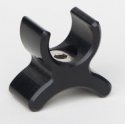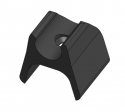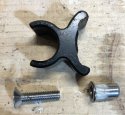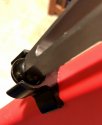egervaswatson
New Member

Fig. 1: The finished product.
A little over a year ago, I invested in a Steerstopper for my S40. It's a well-designed device, but not designed for a Cruzbike. The receivers are all more or less intended for a cylindrical top tube, and don't interface well with the main beam on the S40. That said, I limped along with it. I performed the sphincter-clenching operation of drilling a hole in the S40's frame to install a threaded insert, 3D-printed a little shim to conform the underside of their 1¼" receiver a little more closely to the Cruzbike's flat surface, and...it worked okay.

Fig.2: The OEM steerstopper receiver.
For starters, I drilled the hole slightly too far back, so the receiver was holding the ball tip of the steerstopper rather tenuously. More to the point, though, the rather narrow profile of the receiver and mismatched interface shape meant that it wanted to twist a bit if any torque was placed on the front wheel or boom, with inadequate stabilization around both the axis of the top tube and the bolt holding it in place.
The final straw was when my bike fell over the other day and broke the receiver. That's hardly the manufacturer's fault; that was a lot of torque. But it meant I could either shell out for another compromise, or make something better.

Fig. 3: The 3D model
I designed it to conform to the S40's top tube's cross-section, with more stabilization to prevent rotation around the previously mentioned troublesome axes. I also designed it to acommodate my slightly misplaced threaded insert, and have more relaxed tolerances overall in that regard.

Fig 4: Installed.
I printed it in extremely tough but somewhat pliable nylon, with slightly thicker walls than the original to make up for 3D printed plastic's lower strength compared to machined or injection molded parts. I also accounted for the anisotropic nature of 3D printed parts and oriented the layers for maximum strength.
I suspect this receiver may be weaker in real terms than the original, but the reduction in materials strength is more than made up for by eliminating the design compromises that hindered the original.

Fig. 5: Another angle.







